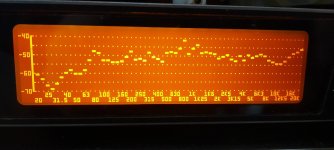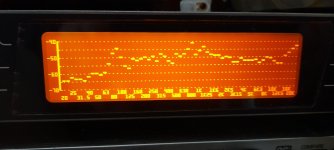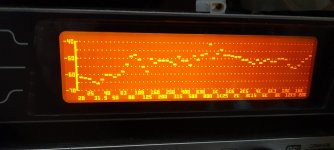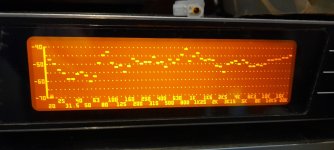I made a panel a few days ago that I had to test tonight for curiosity's sake. I wanted to see how a panel with PVA applied that is the same weight as rubberized undercoating would perform. I made a panel that started same size and weight (48g) as Dupli-Color x2 panel. Dupli panel is 71g after treatment and PVA panel ended up at 87g after treatment. I bit heavier, but ok. Guess I should have weighed the PVA before applying.
On the IR graph the PVA is almost as good as Dupli. Heavy PVA is better damped than light PVA, but heavy PVA is only about as good as light Dupli. Heavy Dupli is a little better. The HF on PVA tanked sooner than light PVA and much sooner than heavy Dupli. FR below 7k is about the same, though PVA is a bit more hairy at 1m. Distortion is about the same. GD is also a little better on Dupli.
The PVA makes the panel a good bit more rigid than Dupli, but it seems like maybe that rigidity is not helping.
Red is heavy Dupli-Color, teal is heavy PVA, copper is light PVA. Very close mic.


I keep circling around this idea that the panel needs to be more like jello; be able to jiggle well. But also stop jiggling as soon as the initial impulse stops. When the panel is too stiff it shows up in the loss of HF because, it seems to me, the stiffness prevents sufficient jiggle / ripple of the panel's surface.
On the IR graph the PVA is almost as good as Dupli. Heavy PVA is better damped than light PVA, but heavy PVA is only about as good as light Dupli. Heavy Dupli is a little better. The HF on PVA tanked sooner than light PVA and much sooner than heavy Dupli. FR below 7k is about the same, though PVA is a bit more hairy at 1m. Distortion is about the same. GD is also a little better on Dupli.
The PVA makes the panel a good bit more rigid than Dupli, but it seems like maybe that rigidity is not helping.
Red is heavy Dupli-Color, teal is heavy PVA, copper is light PVA. Very close mic.
I keep circling around this idea that the panel needs to be more like jello; be able to jiggle well. But also stop jiggling as soon as the initial impulse stops. When the panel is too stiff it shows up in the loss of HF because, it seems to me, the stiffness prevents sufficient jiggle / ripple of the panel's surface.
I actually find that my DML speakers have extremely good imaging with very clear stereo image even if you are not positioned in a sweet spot.
When it comes to directivity, I find that the tail of the sound matters much less than the initial transient. That is the ques our ears use to determine from where a sound comes from. Looking at your responses, it looks like the DML has a weaker initial transient than the other speakers. If you want good imaging I would focus on improving that instead of reducing the tail.
When it comes to directivity, I find that the tail of the sound matters much less than the initial transient. That is the ques our ears use to determine from where a sound comes from. Looking at your responses, it looks like the DML has a weaker initial transient than the other speakers. If you want good imaging I would focus on improving that instead of reducing the tail.
That is a great point, thank you for mentioning that. I think lightness of panel must be required to improve that, but the heavy exciter hanging from the light panel surely complicates the settling time. I did order a huge magnet last weekend so I am obviously going to have to test it this week with just a coil taped to panel 😛
For initial transient analysis I zoomed in on the no-baffle planar IR and the dupli x2 panel at 1m mic:
Green is planar at 1m, purple is Dupli x2 rubberized at 1m
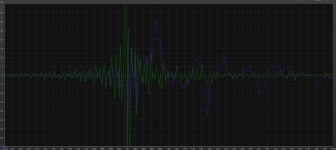
I did not take a close-mic measurement of no-baffle planar, unfortunately, but even at 3ft its IR looks better than the best DML at close-mic. Here is a close-mic comparison of heavy PVA and Dupli x2. Dupli looks significantly better here.
Blue is heavy PVA close-mic, red is Dupli x2 close-mic
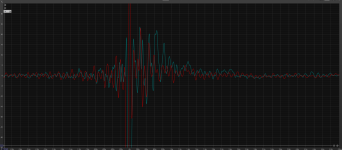
For initial transient analysis I zoomed in on the no-baffle planar IR and the dupli x2 panel at 1m mic:
Green is planar at 1m, purple is Dupli x2 rubberized at 1m

I did not take a close-mic measurement of no-baffle planar, unfortunately, but even at 3ft its IR looks better than the best DML at close-mic. Here is a close-mic comparison of heavy PVA and Dupli x2. Dupli looks significantly better here.
Blue is heavy PVA close-mic, red is Dupli x2 close-mic

So it's been a few years since I built my DML panels. they are approx 300x1200x4mm plywood with 1x DAEX25FHE-4 each and chamfered corners.
I was thinking of upgrading them for performance (with a subwoofer crossed over) and was wondering what the current thoughts are on design:
I was thinking of upgrading them for performance (with a subwoofer crossed over) and was wondering what the current thoughts are on design:
- Would adding a second same exciter in series improve volume and FR? I did see a vid where someone tested a number of configurations and it seemed like doubling the exciters up made the most difference.
- Is moving to honeycomb sandwich cardboard going to improve SQ much? I like the look and weight of the wood and it seems pretty stiff yet flexible.
- Are these exciters trash? Has there been a big bump in performance in the last few years with newer models?
Last edited:
One other question I forgot-- Is hanging them a couple inches from a wall (like from wall mounted hooks) problematic?
Here's a comparison of DAEX32EP-4 and XT32-4, close mic, each on the same panel in same frame with no driver bracing. Only thing that changed was the driver. Every time I remount a driver there may be a slight change in the exact mounting point, but they were pretty close:
Red is EX32. Green is XT32


I only did this one test with an XPS panel, no other materials. My summation is that there isn't much difference between the two in these measurements. The XT32 may have a little better HF or that could have been caused by placement. The XT32 feels better to work with though, seems more resilient than the EX32 and less prone to getting damaged be remounts, but XT32 has a smaller foot ring which does not stick as well to the panel with tape. Less surface area to bond over.
Red is EX32. Green is XT32
I only did this one test with an XPS panel, no other materials. My summation is that there isn't much difference between the two in these measurements. The XT32 may have a little better HF or that could have been caused by placement. The XT32 feels better to work with though, seems more resilient than the EX32 and less prone to getting damaged be remounts, but XT32 has a smaller foot ring which does not stick as well to the panel with tape. Less surface area to bond over.
Oops, I meant EX32 may have a little better HF in that measurement but idk if it is actually the driver or the placement because I think I've seen others post measurements with the XT32 having improved HF. The 3ft test suggest the tiny difference in placement is likely involved here because EX32 has bigger peaks and dips:

Oops, I meant EX32 may have a little better HF in that measurement but idk if it is actually the driver or the placement because I think I've seen others post measurements with the XT32 having improved HF. The 3ft test suggest the tiny difference in placement is likely involved here because EX32 has bigger peaks and dips:
Is there any kind of consensus on which exciters are the best performers at various wattage levels?
Hello moray.
Sorry for the delay.
I get very little time in my room lately.
Pic 1 is the veneer panel with a small dot of blu-tack in the centre of the coil area.
Pic 2 is with a small plastic dome taped to the coil area using double sided tape.
Pic 3 was with the tape only to see what affects it was having.
Pic 4 is with a 14mm hole drilled in the coil area , and the same dome glued into place.
Pic 5 is the picture of the dome in place.
Although the small dome does give a slow rising frequency response from 6k up to 20k of about 6db without any major dips and peaks.
It does not have any impact on the peaks in the 1k area , as the coil cavity is unaffected.
It looks like I will have to make a soft dome and see how this affects this 1k plot.
And what happens above 6k.
Steve.
Sorry for the delay.
I get very little time in my room lately.
Pic 1 is the veneer panel with a small dot of blu-tack in the centre of the coil area.
Pic 2 is with a small plastic dome taped to the coil area using double sided tape.
Pic 3 was with the tape only to see what affects it was having.
Pic 4 is with a 14mm hole drilled in the coil area , and the same dome glued into place.
Pic 5 is the picture of the dome in place.
Although the small dome does give a slow rising frequency response from 6k up to 20k of about 6db without any major dips and peaks.
It does not have any impact on the peaks in the 1k area , as the coil cavity is unaffected.
It looks like I will have to make a soft dome and see how this affects this 1k plot.
And what happens above 6k.
Steve.
Attachments
Moray.
I just remembered that I was going to try the cling film method first, before cutting the hole 🙄
Never mind,
I'm not sure if the dome is big enough, I usually cut the hole the size of the coil foot.
I know that at some stage I am going to lay the panel down and flattened the dome.
It is inevitable.
Lets hope i can do some tests first.
I will then have a concave dome .
Maybe tomorrow.
Steve.
I just remembered that I was going to try the cling film method first, before cutting the hole 🙄
Never mind,
I'm not sure if the dome is big enough, I usually cut the hole the size of the coil foot.
I know that at some stage I am going to lay the panel down and flattened the dome.
It is inevitable.
Lets hope i can do some tests first.
I will then have a concave dome .
Maybe tomorrow.
Steve.
Eucydomes don't flatten...And I note you see a positive hf response with the dome. There you go...nuff saidI know that at some stage I am going to lay the panel down and flattened the dome.
It is inevitable
With all the frequency response graphs provided throughout this entire Thread ...
Do any people recognize the benefit of adding a Super Tweeter with a 10Khz crossover ???
Do any people recognize the benefit of adding a Super Tweeter with a 10Khz crossover ???
Mister audio.
Most of the graphs on this forum have poor hf responses and some struggle to reach 10k.
Some of my whizzer and dome tweeters reach down to 2k.
But you have to match the efficiency of the two materials, which can be a problem.
My fabric domes are more for reducing coil cavity resonances and the mess caused by distortions in the coil surface area, than for increased hf, but it can be a help sometimes.
Some , on this forum might tell you that you cannot hear much above 10k, so what is the point?
The choice is yours.
Steve.
Most of the graphs on this forum have poor hf responses and some struggle to reach 10k.
Some of my whizzer and dome tweeters reach down to 2k.
But you have to match the efficiency of the two materials, which can be a problem.
My fabric domes are more for reducing coil cavity resonances and the mess caused by distortions in the coil surface area, than for increased hf, but it can be a help sometimes.
Some , on this forum might tell you that you cannot hear much above 10k, so what is the point?
The choice is yours.
Steve.
I wouldn't tell anyone that they can't hear much above 10k, but I know that I can't. 11k just maybe, but that's it.Some , on this forum might tell you that you cannot hear much above 10k, so what is the point?
Eric
Apologies for possibly dumb question, but how well do exciters work on curved surfaces? Assuming one could find a stable flat mounting point, would the panel work in the same way if it were bent from flat to a 180 degree curve?
Would appreciate any thoughts as it's been bothering me.
Would appreciate any thoughts as it's been bothering me.
But you have to match the efficiency of the two materials, which can be a problem.
I have built a great pair of DML's and did use Super Tweeters. I didn't find any difficulty matching efficiency & phase.Some , on this forum might tell you that you cannot hear much above 10k, so what is the point?
Just because some people have poor hearing, why should all build for poor high frequency performance?
In fact, people use EQ to compensate for their hearing. Simply adding a cheap Piezo Tweeter can achieve this 🙂
( clarity and 'air' is an important part of music reproduction )
If the bend is stress formed (ie bent in the normal sense), it will affect the reproduction. If it is done by heat/steam and then freely held, it will have less effect, but will still respond differently to a flat panelApologies for possibly dumb question, but how well do exciters work on curved surfaces? Assuming one could find a stable flat mounting point, would the panel work in the same way if it were bent from flat to a 180 degree curve?
Would appreciate any thoughts as it's been bothering me.
Try it out...👌👍
Eucy
Hello SapphireSlotYeah, I think the issue is too much reflection from everywhere, and DML have really wide directivity which makes that problem even more apparent. If I put lots of absorption on the walls that might resolve the problem, as could having a much wider room, but I can't do either right now. I'll move in a year though and maybe then I can revisit this.
I just realized that the inside vs outside test showed this problem pretty clearly on the IR graph, as does the close-mic vs 1m-mic:
(green is outside, red is inside, both 6ft (2m) mic distance)
View attachment 1330372
When measuring a DML in the test position from 3ft (1m) and comparing to a 3" planar there is a big difference in the room effect on the impulse graph:
(red is planar in a box, green is planar no-baffle, purple is DML)
View attachment 1330461
When I changed the DML freq sweep to 1kHz-20kHz this impulse response got a bit worse, so it's not LF causing this.
Sorry to be late for this reply. Directivity of the DML and how it fits with the room setup is among my current question too.
As suggested by Leaob, I would focus also on the transient. More precisely on the first 50ms and in that what happens in the first 10ms and between 10ms and 30ms. I would expect the main front to be almost aligned over the frequency range with no jump of some ms due to a reflection on a "too close" wall.
we have
Currently, I am in the idea of panels with a high coincidence frequency. A the coincidence frequency, there is a strong emission at about 90° (parallel to the panel plan). When the frequency increases, this angle reaches the axe. It is shown in different papers about DML and we have evidence of it in the sharp first reflection in the IR.
In "quite reverberant" room (I have no figure), this reflection might be stronger than the direct sound and it will reach the listener with a delay causing a jump in the wave front.
The spectrogram helps to see that.
Could you share the REW file of the planar compare to your DML?
About low frequency, they are not visible in the IR but you can see them in the step response.
Christian
@homeswinghome here you go: https://ninjafiles.io/B9P/planar-vs-rubberized-xps.mdat
I'm speculating that the directivity is just really wide for all frequencies so in a medium-small living room without any treatment the center image loses focus. If my room were bigger or if there were a lot of absorbers on the walls then it would probably sound a lot better to me.
I think DML is best suited for a large open area (PA), but probably not the best for stereo in a living room. It might be a good center channel though.
I've been doing a lot of research into open baffles, dipoles, cardioids, and directivity / imaging in general and it seems to me that the best speaker should be made to target the listening window while minimizing the influence of the room by sending less energy outside of the listening window. I don't think there's a good way to do this with DML.
It's just a theoretical personal preference at this point, but I don't think I want to add artificial spaciousness with wide directivity speakers in a reflective room. Adding absorbers in the family area is not an option for me, so I'm looking at different kinds of speakers to better control the directivity.
I'm speculating that the directivity is just really wide for all frequencies so in a medium-small living room without any treatment the center image loses focus. If my room were bigger or if there were a lot of absorbers on the walls then it would probably sound a lot better to me.
I think DML is best suited for a large open area (PA), but probably not the best for stereo in a living room. It might be a good center channel though.
I've been doing a lot of research into open baffles, dipoles, cardioids, and directivity / imaging in general and it seems to me that the best speaker should be made to target the listening window while minimizing the influence of the room by sending less energy outside of the listening window. I don't think there's a good way to do this with DML.
It's just a theoretical personal preference at this point, but I don't think I want to add artificial spaciousness with wide directivity speakers in a reflective room. Adding absorbers in the family area is not an option for me, so I'm looking at different kinds of speakers to better control the directivity.
- Home
- Loudspeakers
- Full Range
- A Study of DMLs as a Full Range Speaker
